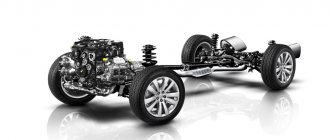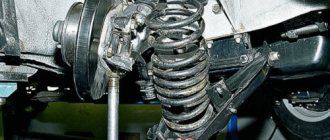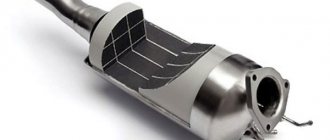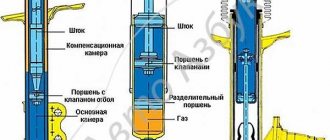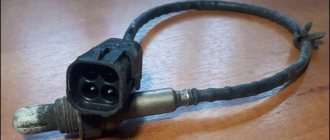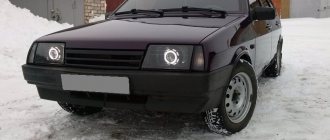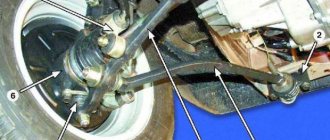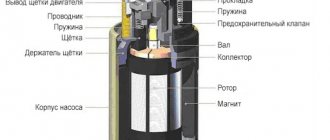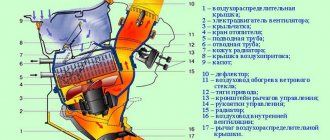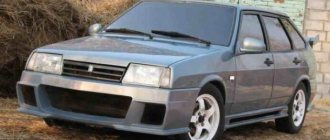Diagram and designations
The rear suspension components are slightly smaller compared to the front. Because of this, the design can be called simpler. But this does not in any way reduce the degree of responsibility of you, as the driver, for the good condition of the unit.
Rear suspension diagram
Having familiarized yourself with the node diagram, you can move on to the elements that are indicated on it.
| Item number | What is |
| 1. | Wheel hub |
| 2. | suspension arm |
| 3. | Lever fixation bracket |
| 4. | Lever joint bushing (rubber) |
| 5. | Lever joint bushing (spacer) |
| 6. | Suspension arm fixing bolt |
| 7. | Car body bracket |
| 8. | Support washer for fastening the strut rod (shock absorber) |
| 9. | Upper spring support |
| 10. | Spacer |
| 11. | Rear suspension spring insulation gasket |
| 12. | Spring |
| 13. | Strut rod mounting pads |
| 14. | Compression Progress Buffer |
| 15. | Shock absorber rod |
| 16. | Shock absorber protection cover |
| 17. | Lower spring support cup |
| 18. | Shock absorber |
| 19. | Rear suspension arm connector |
| 20. | Hub axle |
| 21. | Cap |
| 22. | Rear wheel hub fixing nut |
| 23. | Sealing ring |
| 24. | Wheel bearing washer |
| 25. | Wheel bearing |
| 26. | Brake shield |
| 27. | Retaining ring |
| 28. | Dirt-reflecting element |
| 29. | Rear suspension arm flange |
| 30. | Rear suspension shock absorber bushing |
| 31. | Lever bracket with lugs for shock absorber mounting |
| 32. | Rear suspension arm joint, rubber-metal type |
Device Features
Having understood the diagram, you should separately talk about what the design of the rear suspension of the domestically produced VAZ 2109 is. Knowing all the features and nuances of the suspension elements used, you will know how to carry out further repairs, preventive maintenance, and what parts to buy for replacement old.
- The VAZ 2109 uses a torsion-link rear suspension design. The guiding device here is a pair of longitudinal arms, which are connected to each other using an elastic connector. Since the connector is shifted forward relative to the wheel axis, the kinematic properties of the rear suspension of the nine correspond to the features of an independent suspension on trailing arms.
- The independent movement of each wheel is ensured by twisting the amplifier with a U-shaped cross-section. This section is characterized by low torsional rigidity and high bending rigidity. This makes the structure quite reliable and durable.
- The trailing arms are made of pipes. They are welded to the connector through the rear suspension arm reinforcements, which makes it possible to create a single beam. It is hingedly suspended through a bracket on the car body.
- Each of the rear suspension arms in front is equipped with a bushing into which rubber-metal joints are pressed. They consist of a pair of bushings - rubber and metal.
- Through the spacer sleeve there is a bolt that connects the suspension arm and the stamped bracket, which is mounted to the body bracket using bolts, nuts and washers. A self-locking nut is screwed onto the mounting bolt.
- Brackets with lugs are welded to the back of the levers, which are used for mounting shock absorbers, and flanges are necessary for attaching the rear wheel hub and brake shield using bolts.
- The elastic components of the rear suspension include springs and a compression stroke buffer.
- The spring is made of spring steel with a round cross-section. It is installed on the shock absorber and rested with its lower part on the cup. The upper part rests on a support, which is welded to the inner arch of the car body. The lower spring support cup is welded to the shock absorber. A rubber insulation gasket is installed between the upper support and the spring.
- Rear suspension springs are divided into two classes, depending on the control load along the length - A and B. Class A is marked in yellow, applied to the outer side of the middle coils. Class B has a green designation.
- The compression stroke buffer is made of polyurethane. It is mounted on the shock absorber rod inside the spring. From above, the buffer rests against the cover of the protection casing, but when it is put into operation, it rests on a support.
- The buffer support is pressed onto the top of the shock absorber reservoir.
- The buffer has annular grooves on the outer surface that determine the location of deformation.
- The protection casing provides protection from mechanical damage and contamination of the rod and compression stroke buffer. The casing is made of corrugated rubber, which allows you to change the length when the suspension is operating. There is a ring groove at the top inside the casing. They serve to enter the spent part of the steel cover. At the bottom, the casing is quite elastic, which allows it to be pressed against the spring support cup.
- The rear wheel axle is mounted to the lever flange using 4 mounting bolts. The same bolts are used to secure the brake shield.
- The hub rotates on an axis on a double-row ball bearing. The hub is mounted to the axle using a nut and thrust washer. The nut is installed on the axle by crimping its collar into the groove of the axle.
- The bearing is mounted in the hub using a retaining ring. The bearing is closed and contains almost permanent lubrication.
- The inside of the hub is sealed with a pair of dirt-reflecting rings. One of the rings is welded to the hub, and the second to the axle flange. A labyrinthine seal is formed between them.
- The outer cavity of the hub is closed by a cap. There is an O-ring between the cap and the hub.
- During operation of the VAZ 2109, the hub bearing is not adjustable and is not lubricated. The wheel disc is mounted to the hub using 4 mounting bolts.
- The shock absorbers on the rear suspension of the nine are hydraulic telescopic double-acting.
- The lower eye shock absorber is installed on the lower arm bracket using a bolt and a self-locking nut.
- The upper fastener of the shock absorber is pin-type - the rod is mounted to the upper spring support through a pair of rubber pads and a support washer. There is a spacer between the protection casing cover and the washer.
The design of the rear suspension cannot be called simple, since there are many elements that interact with each other. If this effective interaction is lost, the car begins to behave unstable and requires repair or replacement of certain components.
It is not difficult to understand the diagram and structure of the rear suspension of the VAZ 2109 car. This will allow you to significantly save on repairs, avoiding visits to service stations, and also develop your own skills in independently repairing your own car.
How to change a diode bridge in a generator
To perform the work you need to acquire:
- a set of heads;
- flat screwdriver;
- curly screwdriver;
- new diode bridge.
Note! Basically, the generator stops charging the battery due to a faulty voltage regulator or breakdown of the diode bridge. For more detailed diagnostics, it is recommended to remove the device from the engine compartment and install it on a plumbing installation.
Replacement of the bridge must be carried out in a certain sequence:
After removing the diode bridge, check the current flow in the circuit. This can be done using an ohmmeter or a special tester. If the semiconductors fail, the bridge will need to be replaced completely.
Note! It is difficult to replace individual parts of the bridge yourself; this requires certain skills.
- To reach the diode mounts, you need to remove the brush block from the generator. The bolts that hold the back and front covers are unscrewed. One part of the device is removed from the stator.
- Half of the generator is set aside. Using a socket wrench, unscrew the nuts securing the stator winding leads to the rectifier unit. The middle area of the device will be disconnected only after the negative wire is detached from ground. Also, the bolts with the corresponding insulators and the diode bridge itself are removed from the back cover.
- The new diode bridge is installed in its place. Now bolts with insulators are placed in the cover, the winding terminals are put on them and tightened with nuts.
- The rotor and front cover are installed into the rear through the stator. The generator housing is tightened using bolts. At the last stage of work, brushes are installed.
As you can see, the process of changing the diode bridge is not complicated; it is recommended to watch videos and photos to do the work yourself. In addition, the novice car mechanic is provided with additional instructions with a detailed description of the processes. Since the price of service stations is not acceptable for everyone, many try to repair their car themselves.
Source
https://masteravaza.ru/generator/remont-generatora-generator/vaz-2109-zamena-diodnogo-mosta-v-generatore-690
Rear suspension of VAZ 2109
A fairly large number of VAZ-2109 owners prefer to repair their car themselves, since the design of the “nine” is distinguished by its simplicity. But before you start working, you must first find the cause of the problem, and, of course, know the sequence of actions.
VAZ-2109 - what the rear suspension consists of
All of the above fully applies to the chassis. Neither the front nor the rear suspensions are complex in design. Accordingly, repairs and troubleshooting should not cause any problems. In this article we will look at the design features of the rear suspension of the VAZ-2109. First, let's list its elements:
- hub;
- spring and its cups - lower and upper;
- lever mounting bracket;
- shock absorbers and their cushions;
- silent blocks;
- compression progress buffer;
- lever connector;
- rubber gasket;
- beam arm and connector;
- stock;
- spacer;
- support washer.
Generally speaking, the rear suspension of the “nine” is independent, torsion bar. Due to the not very high quality of domestic roads, especially in the outback, it is the chassis that bears the most serious load. Every hole or pothole that a wheel hits is a very noticeable blow to the suspension. You can understand that there are some problems here by hearing. In this case, you will hear an extraneous knock. It can be either deaf or voiced. Experienced professionals use it to make a “diagnosis”, and with very high accuracy. Accordingly, as soon as you hear that something is knocking in the suspension, you should immediately start looking for the problem.
By the way, many car owners strive to improve this component of the car. As a rule, the most common tuning is spacers, which increase the already fairly decent ground clearance. Stock springs and shock absorbers are also often replaced. There are some nuances here. If you change springs, make sure that they have the same stiffness front and rear. However, in this case there is still one exception. The springs at the front may be softer than at the rear, but not vice versa.
When doing such work, you should remember that we are talking about your safety. Accordingly, all installed parts must be of high quality. Products from well-known brands cannot be cheap - otherwise they are fakes, the installation of which can easily result in loss of control of the car while driving.
Another point - when tuning the rear suspension, you don’t need to make it too hard or too soft. In both the first and second cases, this will only bring discomfort to driving. Also, don't lift up the rear too much. It is quite possible that someone really likes this appearance. However, such a design change significantly worsens handling.
About malfunctions 2109.
Visual factors that indicate the need to repair the VAZ chassis are stains on the shock absorbers. In this case, it is necessary to replace the shock absorbers with new ones. The malfunction of the constituent elements (discs, valves, bushings and springs) will be confirmed by low return during compression.
Seals.
It is necessary to replace the rubber elements of the system if an unpleasant creaking or periodic knocking occurs in the chassis. It is better to change elements in pairs. After all, when one element fails, more pressure is placed on the other, which contributes to its faster wear. The 2109 ball joint is one of the weakest points of the suspension. In order to identify the causes of the malfunction of this part, it is necessary to remove the wheel, as well as the plugs. Depth measurements should provide indicators of eleven point eight millimeters. Otherwise, it is necessary to replace the supporting part. This will help prevent the ball from flying out completely if there is a strong blow to the upper part of the body.
Here, it is especially important to pay attention to the end of the lever and the middle of the supporting part, they are especially weak
Bearings.
A wheel wedge indicates “dead” bearings or a damaged VAZ hub. These elements must be replaced every 130 thousand km. You should not wait until these elements are completely worn out to extend the life of your chassis. The main symptoms of this malfunction are; additional noise when cornering and braking.
Replacement is also carried out in pairs - on the front and rear wheels, to reduce the frequency of replacing elements. For cars with rear-wheel drive, it is necessary to lubricate and change the rubber hub holders, with the replacement of brake discs - every 40 thousand km
For this type of car, if fluid gets on the brake discs, you need to pay attention to the hubs. Cars with front-wheel drive do not require periodic lubrication of bearings
Replace bearings in a specially prepared and clean place using a clean tool. Even a small amount of dirt and sand can cause the element to break down and cause premature damage.
To increase the service life of bearings, it is important to prevent dust from entering it. We use the lubricant recommended by the manufacturer
It is better not to save money to maintain long-term functioning. It is important not to overdo it with efforts on the surface (no hammer blows, etc.). If the hub assembly moves, it will be necessary to change the bearing again.
The sealing surface also requires careful attention. Sharp tools can break the seal of the element. Corrosion and moisture entering the element contribute to its failure. Depending on the make and model of the car, brake repairs vary. For general instructions on this type of work, you must refer to the instructions (for a specific model).
Suspension and clutch.
The front suspension is always the main control element of the car. She primarily reacts to the condition of the road. Elements of the front chassis periodically fail. If the upper arm is faulty, then the entire axle must be replaced (upper and lower arms). If the suspension knocks, it means that the structure of the seals has been damaged. The issue can only be resolved by completely replacing the rubber components. The clutch is checked with the engine off. It is necessary to press the pedal several times to detect extraneous sounds. If the data is available, then this is a direct signal about the need for repairs. The pedal travel (from the floor to the state, without pressure) should be one hundred forty-six millimeters. The smoothness of the pedal stroke is also a significant indicator of the proper operation of the clutch. If increased pressure on the pedal is required, repair is required. If, when you engage gear R, an unpleasant sound occurs, the clutch discs are faulty.
https://youtube.com/watch?v=_goCAPndjGA
Carry out timely diagnostics of your car to prevent serious damage to the chassis. Timely maintenance will ensure the safety of you and your passengers.
Rear suspension 2108/2109
I decided to work on the rear suspension, because... I’ve never done it, but I want to learn, so I have some questions...
1. Does it make sense to install polyurethane
silent blocks in the beam, in the shock absorber, “donuts”? Because the rear suspension is rebuilt once every hundred years, maybe it’s worth installing polyurethane) 2. Have you heard that the original “donuts” are not a fountain, they are much more effective than the SS-20 or Acomi? 3. Does the bump stop really give something, if not underestimated? Who installed/would install which ones?) 4. Is it worth installing sound insulators? I doubt their effectiveness)
Shocks are ok! Stock. Well, so that everything works out on a budget)
Well, tell us different secrets, who did it, what did they install?..
Diagnostics
It would be wisest if you do not wait for a breakdown and diagnose the chassis. There is no consensus on its timing - each specialist has his own opinion on this matter. The mileage recommended for vehicle maintenance varies from ten to thirty thousand kilometers. First of all, you need to focus on operating conditions - if you drive on broken country roads, this figure will be minimal. So:
- The diagnostic procedure includes checking the degree of wear of the shock absorbers. In car services, it is done with a special device that checks the elasticity of the spring. It is impossible to determine the degree of wear visually. Springs that have lost their elasticity may break.
- Be sure to inspect the spring cups, which may also have defects and damage. They check the play in the VAZ CV joint - a torn boot can create problems. Inspection of ball joints and tie rod ends is also necessary.
- Silent blocks are connecting elements between the frame and suspension; due to this worn-out part, the smoothness of the car is lost. Both brake pads and wheel bearings are subject to inspection, and the tightness of the hoses is checked.
- Computer diagnostics makes it possible to identify and promptly eliminate even minor faults, which will protect parts from more significant damage.
- When you fall into a hole or hit a curb, the rims are the first to suffer. The rim of the disc may bend, which will certainly be felt when moving. An iron or cast disk can be rolled, but a forged one cannot be repaired. It will simply burst upon impact.
- The wheels of any car need periodic balancing and checking tire pressure. It should be as prescribed by the operating instructions. When changing wheels seasonally, you need to alternate their installation from the front to the rear axle, which will balance out the abrasion of the tires.
Wheel balancing
If these simple rules are not followed, not only the tires will wear out, but also the steering, braking system and transmission elements. Timely maintenance of the chassis is the key to your safety on the road.
Replacement
To replace or partially repair you have to go through a rather labor-intensive path.
You will need the following set of tools and materials:
- Screwdriver Set;
- Set of wrenches;
- Jack;
- Partner.
Decide in advance whether you are going to change the entire assembly, or whether you want to change only the damaged elements of the rear pillar. The volume of your purchases depends on this.
You can start working. Based on our instructions and the video lessons provided, you will be able to replace the rear struts yourself.
- Turn the gearbox into first gear mode.
- Raise the rear wheels using a jack.
- Install supports, strengthening the reliability of fixing your car in a given position.
- Remove the racks. To do this, first go to the trunk, remove the decorative rubber plug, which is located on top of the rack mount. It is better to remove all unnecessary things from the trunk.
- Take a 17-size spanner and a 6-size open-end wrench. With their help, you can unscrew the nut with a spanner, and the open-end wrench will be useful for holding the shock-absorbing strut rod.
Removal process
- That's it, this allows you to remove the mounting nut, support washer, spring washer and top pad without any problems.
- Now we go under the car to finish what we started.
- Take a 19 mm wrench and remove the shock absorber mounting bolt to the rear beam. Remove it.
- In some cases, problems may arise with dismantling this bolt, since it simply sticks. To do this, pre-treat the bolt with the almighty WD40 and give it time to react.
- If even this method did not help, then you will have to take the guide and simply knock out the fastening element.
- Next, remove our shock absorber along with the spring.
- Do not forget that during such manipulations most often the spring gasket remains on the body. It sticks to the metal. Many people forget to take it out, which causes difficulties during reinstallation. Don't make this mistake.
- Clean all the seats to make it more convenient for you and make it all look more aesthetically pleasing. Plus, neatness never hurts to extend the service life of new spare parts.
- To make it more convenient for you, wrap the gasket on the new spring with electrical tape, or secure it with thin wire. This will prevent it from slipping when you begin installation.
- When putting the assembly back together with the new rear strut, be sure to make sure that the raised portion of the spring cup faces the direction of the wheel.
- Secure the lower end of the rack with a nut and bolt, but there is no need to tighten the fasteners just yet.
- Using the lever of your jack, raise and lower the rear of the car. This is necessary in order to eventually insert the shock absorber rod into the hole in the body of your nine.
- With the spring in place, pull the shock absorber rod out to its full length.
- Insert the rod into the lower ear and secure with a bolt.
- Place a jack under the beam and begin manipulating the lifting mechanism.
- At the same time, the spring will begin to compress, and the rod will move towards the glass.
- You or your assistant must be alert in the car in order to have time to pry the rod with a screwdriver and ensure it is directed in the right direction.
- Once the rod is in place, the work can be considered almost complete.
- Fix the rod, not forgetting to insert the cushion, washer and engraver. All this is securely fixed.
- Now you can lower the car onto its own wheels and fully tighten the bolt of the lower shock absorber mounting.
Re-assembly stage
Changing rear rack assemblies is easier and faster than dismantling, disassembling the old rack, looking for defects in it and replacing individual damaged components. But this requires less financial costs.
Changing racks is not that difficult, even if you have little experience in such matters. But if there are none, be sure to contact trusted car services. Do not risk your own car, otherwise subsequent repairs will be even more difficult and expensive.
Description of design
The rear suspension is with 12 coil springs and 10 double-acting hydraulic telescopic shock absorbers.
The main load-bearing element of the suspension is a beam consisting of trailing arms 14 and a connector 13, welded together through reinforcements. At the rear, brackets 15 with eyes for attaching shock absorbers 10 and flanges for attaching the rear wheel axles and brake shields are welded to the suspension arms. At the front, the levers 14 are equipped with welded bushings with silent blocks 3 pressed into them. A bolt passes through the central bushing of the silent block, connecting the lever to the bracket 2. Three welded bolts are provided to secure the bracket to the body spar.
The suspension spring 12 rests with its lower end on a cup welded to the shock absorber reservoir, and with its upper end, through a rubber gasket 11, on a support welded from the inside to the body arch.
The lower eye of the shock absorber is bolted to bracket 15 of the suspension arm, and its rod is secured to the upper support of the suspension spring through two rubber pads 8 (one at the bottom of the support, the other at the top) and a support washer 7 (under the nut).
The rear suspension springs are divided into two stiffness classes according to their length in the free state and under load: A (more rigid, “high”) and B (less rigid, “low”). Springs of the same class must be installed on the front and rear suspensions. But in exceptional cases, if class A springs are installed in the front suspension, class B springs can be installed in the rear suspension (but not vice versa!). The quality of the springs can be fully assessed by the performance of the suspension on the car. If the suspension often “breaks through” to the bump stops on uneven roads or sags under load, stiffer springs should be installed. When replacing springs, do not forget to check the serviceability of the shock absorbers - after all, it is the shock absorber-spring pair that largely determines the characteristics of the suspension.
The hub has a double-row angular contact ball bearing, similar to the front wheel hub bearing, but smaller in size. The bearing fit on the axle is transitional (with slight interference or clearance). During operation, the bearing does not require adjustment or replenishment of lubricant. It is not allowed to eliminate the resulting play by tightening the nut; the bearing should be replaced. When dismantling the hub, the bearing is destroyed, so it is not recommended to disassemble the hub if the bearing is in good condition.
The need to replace the rear struts on VAZ 2108, 2109, 21099 vehicles arises when the following malfunctions occur: the strut shock absorber has leaked and/or started knocking, the strut spring has broken or sagged.
Necessary tools and equipment
— Open-end wrench at “6”
— Curved socket wrench “17”
Or a special device for unscrewing the rear suspension shock absorbers of VAZ 2108, 2109, 21099 cars.
— Two spanners on “19”
— Assistant (preferably, but not required)
Preparatory work
The work of replacing the rear struts can be carried out both in a pit and on a flat area. It is advisable to replace shock absorbers and strut springs in pairs rather than individually.
— We hang and remove the rear wheels of the car
To do this, loosen the wheel bolts, jack up the car on both sides, place stands under the sills, and remove the wheels.
— We clean the lower fastenings of the struts to the rear beam from dirt
You can treat it with WD-40 and tap the fastening bolts.
The procedure for replacing rear struts on VAZ 2108, 2109, 21099 vehicles and their modifications
— Unscrew the shock absorber rod nut
We remove the rubber plug of the support cup in the trunk of the car and unscrew the nut with a curved spanner set to “17”, holding the rod from turning with an open-end wrench set to “8”.
Remove the nut, under it the spring and support washers, and the upper rubber cushion.
Read also: You intend to drive through the intersection in the forward direction
To unscrew the nut, instead of keys, you can use a special device.
— Unscrew the bolt securing the shock absorber to the beam
Using a wrench or socket set to “19”, unscrew the bolt and hold the nut with another wrench set to “19”. Remove the bolt from the mount.
Problems may arise with unscrewing and removing the bolt, since it is constantly exposed to an aggressive environment and very often becomes very sour. If you managed to unscrew its nut, you can try to knock it out using a mandrel and a hammer. In some cases, heating the bolt with a blowtorch or gas torch helps. In especially severe cases, cut off the bolt with a grinder.
— We remove the rack
Make sure that the upper rubber gasket of the strut spring is removed. If it is not there, then remove it from the support cup from below.
That's it, the rear pillar has been removed.
We repeat the removal procedure for the second rack.
Features of installing a rear pillar on a VAZ 2108, 2109, 21099 car
— We attach the upper rubber gasket to the spring with electrical tape or tape. for ease and accuracy of installation, install the spring on the stand
— Pull out the shock absorber rod until it stops; a spacer sleeve and a lower rubber cushion should be put on the rod
— Insert the shock absorber rod into the hole in the body cup
An assistant puts on the upper rubber cushion, support and spring washers and tightens the nut.
If there is no assistant, then first we attach the shock absorber to the beam, then, placing a stop on the beam, we slowly lower the car body with a jack, periodically checking that its rod fits into the hole. You can pre-tie a wire to the rod and thread it through the hole in the cup. By pulling it out you can direct the movement of the rod.
When installing the shock absorber, it is necessary to rotate it so that the rising part of the spring cup is directed towards the wheel.
— We secure the lower part of the shock absorber, do not tighten the nut completely
— Install the rear wheels and lower the car to the ground
— Press the rear of the car several times to self-install the suspension elements
— Tighten the rod fastening nut and the lower mounting bolt of the strut shock absorber
Notes and additions
— The rear struts of VAZ 21088, 2109, 21099 cars fail less often than the front struts. Therefore, the need to replace them arises no earlier than 100 - 120 thousand kilometers.
More articles on the suspension of VAZ 2108, 2109, 21099 cars
Disassembling and replacing the front suspension: instructions
- The VAZ 2114 is installed on a viewing hole or raised on a lift. The car must be set to the parking brake. It is necessary to remove the wheel caps, loosen the mounting bolts and unscrew the hub nut. Having secured the front of the car, you can remove the front wheels.
- Next, you need to remove the ball joint pin, which is located in the swing arm of the front strut. The next step is to remove the front stabilizer link (number “24”) from the front suspension arm (number “22”). Next, the stretch marks from the body (30) are removed. Next, you need to completely disconnect the ball joint that is attached to the steering knuckle.
- Now you can remove the front suspension arm. To do this, you need to disconnect it from the body bracket (28). Afterwards the lever is removed along with the bracket and the extension (29, 30). It is also necessary to remove the bolts that secure the pads to the steering knuckle.
- In front of the driver there will be a caliper assembly. To avoid problems with it, you do not need to completely remove it; you need to hang the caliper on a hook in such a way that there is no load on the main hose. The next step is to press the spline shank out of the front wheel hub.
- From the side of the engine compartment, you need to remove the protective fist (“41”).
To do this, unscrew the telescopic strut nuts and then remove the solid front suspension strut. It should be together with the wheel hub and steering knuckle. The other front suspension strut is removed in the same way. Next, the racks are removed from the rod. Removing springs using zip ties
When removing the bolts that secure the ball joint to the steering knuckle, you must use a socket wrench. Otherwise, the protective cover of the hinge may be seriously damaged, resulting in additional costs.
In the case of the front suspension, its assembly proceeds in the reverse order, with the exception of a few features. When installing the mounting bracket to the VAZ 2114 body, you need to make sure that the threads of the bushings are not damaged. To do this, you must perform operations carefully. Also, longitudinal displacement of the cushions on the bar must not be allowed. This can happen during installation of the anti-roll bar.
Types of loads and specifics of work
All loads that shock absorber struts take on can be divided into two groups:
- dynamic (rapidly changing);
- conditionally constant (quasi-static).
Dynamic loads occur when a vehicle hits an obstacle. When hitting a bump, the shock absorber first compresses, then rebounds. When a wheel gets into a hole, on the contrary, first rebound, then compression. The task of the shock-absorbing element is to take the blow, dissipate its energy, and convert it into heat. This energy conversion is ensured in all three elements of the shock absorber strut: during spring deformation, gas compression under the piston and the rapid passage of oil through the shock absorber cylinder fitting.
Conditionally constant loads on the shock absorber struts occur when the car moves on a flat road surface when cornering. In this case, the geometric position of the wheel relative to the car body changes much more slowly than when hitting an obstacle.
When moving along an arc of constant curvature at a constant speed, the geometry does not change at all. This means that the task of the device is not to dissipate energy, but to ensure uniform distribution of wheel pressure on the road, prevent skidding, and ensure controllability. The flow of oil through the fittings occurs slowly and is of less importance than the reaction of the spring and gas pressure.
Causes of rear strut failure
Replacing rear struts on a VAZ 2109
There may be several reasons why the rear shock absorber strut is not functioning properly:
- It is possible that the rear wheel wears out the plastic locker that protects the strut while driving. This leads to the fact that over time the wheel “makes its way” to the rack.
- If the strut breaks off along the lower silent block, then most likely the bolt that holds it was not tightened under load.
Note: therefore, when replacing the rack, you need to pay attention to this bolt if you do not want to carry out repair work again soon.
How to understand that the rear pillar needs repair
VAZ 2109 rear strut extension
Signals that repairs need to be done can be different:
- The silent block has changed slightly. Perhaps there are cracks or other types of flaws on it.
- The boot and rubber gasket have become limp and less elastic.
Note: if they haven't broken yet, they definitely will soon. Therefore, it is advisable to replace them in a timely manner.
- The compression buffer is deformed or damaged. Because everything in the system works under high pressure, and the rubber gasket does not work normally, but all this pressure “presses” on the compression buffer. Ultimately, this leads to its breakdown.
- Small cracks appeared on the spring (see Replacing the springs of a VAZ 2110 on our own).
Note: if the spring is somehow deformed, it should be replaced immediately. At the same time, some drivers, wanting to “lower” their car, deliberately cut off several coils of the spring.
Signs of wear or damage to the undercarriage
Leaks under the car in the area where suspension parts are located. Vehicles of the VAZ 2109 model, as a rule, already have a long service life (and the design of the hydraulic cylinders is designed for a certain resource, which they may have exhausted long ago)
There is a high probability that the oil seal or shock absorber rod mirror may wear out, so pay attention to possible leakage of hydraulic fluid (in principle, you need to be careful about any leaks from the car); Knock when driving. Yawing along the road is the most common sign of trouble.
As a rule, this indicates wear or loosening of the components; carefully inspect the suspension, or best of all, contact a workshop; When acting on the suspension (try pressing on the hood or, conversely, lifting your car, experienced auto mechanics, when first getting acquainted with passenger cars, not only the VAZ 2109, roughly assess the condition of the chassis), the suspension does not provide sufficient resistance - the first sign of malfunction hydraulic cylinders. There can be many reasons - insufficient amount of fluid, leakage due to wear of the seals, fluoroplastic bushing, wear of the rod, malfunction of the valve mechanism. It is necessary to replace worn parts, replenish the oil in the cylinders, or eliminate the malfunction of the valve mechanism; When driving (especially on uneven roads), hard shocks with a characteristic sound occasionally appear, which can even be felt on the steering (the so-called “breakdown” of the suspension). The appearance of this symptom indicates that the springs (most often the rear chassis) have lost their properties due to metal fatigue; hydraulic shock absorbers may also not work properly. In any case, it is necessary to inspect the structure of your suspension and make repairs.
We have not yet mentioned the uneven wear of tires - if your wheels are adjusted for wheel alignment and balanced, and the CV joints (since the VAZ 2109 is assembled according to the front-wheel drive scheme) work correctly, then the reason is the chassis, there is a breakdown somewhere, unnecessary backlash or wear.
In conclusion, it should be noted that although the chassis of the VAZ 2109 is not subject to such overloads as a similar truck unit, its design is still quite complex and requires constant attention; fortunately, the suspension design allows for maintenance and repair without large material costs.
Rate the usefulness of the article!
- Why do brake pads squeak when braking and what to do about it
- Replacing engine mounts on VAZ and other cars
- Car rental: what you need to know when choosing
- What does the braking distance depend on and what formula can it be calculated by?
- How well do you understand car emblems?
- How to remove the outer CV joint and replace a torn boot
- How to independently replace the internal grenade on VAZ cars
- Wheels for rotating the car in place 360 degrees
- In 3 years, diesel engines will become a luxury
- Review of the most expensive Hyundai Solaris ever
- Test drive Lamborghini Huracan from Mikhail Petrovsky
